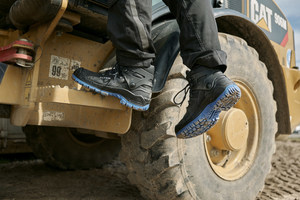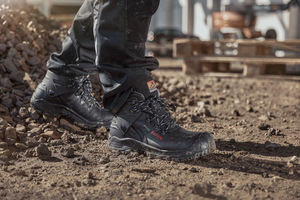
 |
Mark Sennett
Managing Editor |
 |
Kelly Rose
Editor |
| Home> | PPE | >Safety Footwear | >Reduce twist risk |
Reduce twist risk
31 March 2025
MEIKE ACKERMANN and Christopher Neumann provide an insight into the risks of ankle injuries in the workplace, the most common causes, and solutions for accident prevention.

SLIPPING, TRIPPING, and falling – these accidents pose a significant risk in the workplace. Particularly affected are the lower extremities, especially the feet of employees. Workplace accidents caused by twisting an ankle are among the most common and dangerous incidents, often leading to long-term absenteeism and, in more severe cases, permanent disability. For businesses, these accidents not only represent a health burden for the affected employees but also result in substantial financial losses due to production downtimes and high follow-up costs.
Frequency and causes
Accidents caused by slipping, tripping and falling (STF accidents) are among the most common causes of accidents in the workplace. According to the German Statutory Accident Insurance (DGUV), the number of reportable STF workplace accidents was 172,000 in 2018. This figure accounts for about 21% of all reported workplace accidents that year. The most common trigger for such accidents is walking on uneven or slippery surfaces. In particular, in areas where employees frequently have to climb ladders, scaffolding, or machine platforms, the risk is significantly higher. Various weather conditions, such as wetness, snow, or ice, also increase the risk of accidents.
However, it’s not only external factors that contribute to STF accidents. Human factors such as distraction, time pressure, and fatigue also play a role in increasing the likelihood of accidents in the workplace. Employees who work under high pressure or feel rushed over extended periods of time are more likely to make unsafe movements, further increasing the risk of twisting and falling accidents.
Twisting accidents and their consequences
One particularly dangerous part of STF accidents are twisting accidents, where employees lose their footing and injure their ankle or joint. Twisting is a very quick and unexpected movement that often leads to severe injuries. Such accidents are especially common in industries where employees regularly work on uneven terrain or at great heights. Examples include construction, agriculture, logistics, and industry. However, even in professions where employees operate machinery or vehicles regularly, the risk of twisting should not be underestimated.
Ankle injuries, particularly sprains and torn ligaments, are among the most common injuries caused by twisting an ankle. These injuries can lead to significant health problems and require a long recovery period. In severe cases, they can even lead to permanent mobility restrictions or work incapacity. According to the DGUV, in 2018, ankle and foot injuries accounted for 18.4% (144,500 cases) of the most common injuries in reportable workplace accidents. The upper ankle joints are particularly affected, as they are most commonly injured in twisting accidents.
The financial impact of twisting accidents
The impact of twisting accidents is not only significant in terms of health, but also economically. Each year, the costs associated with STF accidents amount to billions of euros in Germany alone. According to an estimate by the German Social Accident Insurance (VBG), the follow-up costs for STF accidents amount to about 330 million euros per year. These costs include both direct expenses, such as compensation payments, and indirect costs, such as downtime and production losses. These figures emphasise the economic importance of accident prevention.
A single workplace accident can be costly for a company. Experts estimate that the cost of an employee being absent due to a twisted ankle injury can range between 300 and 450 euros per day. Additional costs may include higher insurance premiums, payments for pensions in the case of permanent damage, and the need to find a replacement for the injured employee. In high-risk industries such as construction or logistics, these costs can quickly pose an existential threat to smaller businesses.
Risk factors for twisting accidents
Risk factors for twisting accidents can be divided into two main categories: external conditions and human factors. Often, floors, stairs, ladders, ascents, and platforms are the triggers for STF accidents. Additionally, different surface conditions, weather influences, or unevenness can become a hazard. Forty-five percent of all STF accidents occur while walking on level surfaces – often because the floor is too smooth or dirty. Human factors such as distraction, stress, and time pressure also contribute significantly to twisting accidents. Distractions, stress, time pressure, rushed movements, or fatigue from long working hours lead to inattention, ultimately resulting in accidents. Often, a fraction of a second is enough to twist an ankle. Sprains or fractures of the ankle, as well as complex ligament and joint injuries, can then be the result.
Preventive measures to avoid twisting accidents
To minimise twisting accidents, it is crucial to consider both external conditions and human behaviour. Companies can take various measures to improve workplace safety.
When it comes to preventing accidents from twisting and the resulting injuries to employees, the basic equipment of each workplace is often at the forefront: slip-resistant steps, marking of hazardous areas, or proper lighting are key considerations. However, the provision of appropriate personal protective equipment (PPE) – particularly safety shoes – is also essential.
Foot protection offers opportunities
Modern foot protection – in addition to classic safety features such as a toe cap and penetration-resistant midsoles – often includes slip-resistant outsoles that provide more grip on slippery or smooth surfaces. However, to specifically minimise the risk potential for twisting accidents, additional features are necessary. Although the standards for safety shoes do not include requirements for ankle protection, manufacturers have recognised the need and developed preventive solutions. Often, a particularly high and firm shaft is designed to provide the necessary stability in the ankle area. However, this can quickly constrict the foot and, in some cases, cause painful pressure points or even circulation issues. This is because the rigid construction does not optimally follow the natural movement of the lower leg, limiting mobility. This can ultimately lead to the muscles becoming sluggish, diminishing their natural stabilising function. Therefore, the moment such rigid ankle protection is removed, the injury risk is even higher. Furthermore, when wearing conventional high-cut safety shoes, creases often form around the ankle during wear, which causes material fatigue, leading to a further loss of stability. A sensible alternative, which has proven effective in this context, is specialised ankle cuffs that stabilise the ankle while adapting to the natural movements of the foot and knee joints.
Safety shoe features
In addition to ankle protection, other properties of safety shoes are crucial for preventing STF accidents. It is important to pay attention to the optimal fit (length and width) as well as the specific requirements of the workplace. For example, smooth and slippery floors require slip-resistant soles, while deep and uneven surfaces call for a rougher tread profile.
Conclusion
Accidents caused by slipping, tripping or falling consistently rank high on the list of workplace accidents. Twisting an ankle poses a particular danger.
The health-related absence of employees due to serious twisting injuries costs German companies and insurers billions of euros every year. This enormous financial loss is, to some extent, avoidable. The provision of appropriate foot protection for employees can have a significant positive impact on both the frequency and severity of twisting injuries at the workplace. Key factors to consider include: a sensible ankle protection system should provide sufficient stability to prevent injuries while also being flexible enough to support the muscles and not interfere with the body's natural protective mechanism. It should not constrict the foot.
Meike Ackermann is print and digital editor and Christopher Neumann is copywriter for Elten. For more information, visit www.elten.com
- No related articles listed

























